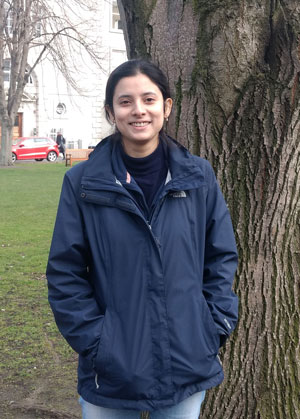Dr Anindita Lahiri

Anindita Lahiri completed her Bachelor degree from the University of Calcutta (India) and went to Pune University (India) for a Master’s degree in Plant Sciences (specialisation: Angiosperm Systematics) and an M.Phil. degree in Plant biotechnology (topic: In vitro production of medicinally important metabolites, shatavarin in Asparagus racemosus Willd. and scopoletin in Evolvulus alsinoides L.). She completed her M.Phil. degree in 2013 and did a six month internship in Calcutta University in a Microbiology Laboratory before coming to Trinity College Dublin (TCD), Ireland. She completed eight months of voluntary intern work in the TCD Molecular Biology and Plant systematics Laboratory and started her PhD in 2015.
PhD project: Endophytic diversity of ash (Fraxinus excelsior L.), and its interaction with the dieback pathogen Hymenoscyphus fraxineus (T. Kowalski) Baral, Queloz, Hosoya.
This project is primarily based on the study of ‘Endophytes’ (especially fungi) living in disease free ash trees in Europe and their use as a biocontrol agents to the Ash Dieback pathogen Hymenoscyphus fraxineus (T. Kowalski) Baral, Queloz, Hosoya. Leaves and roots from Ash trees (Fraxinus excelsior L.) and its close relatives were collected from two different provenance trials (Roosky, Roscommon and Kinsealy) and from the National Botanic Garden, Glasnevin, Ireland for endophyte isolation.
Fungal cultures were obtained on various commercially known artificial media for fungal and morphological studies and DNA characterization used for species identification. DNA barcoding regions including (nrITS, TEF and nrLSU) have been amplified using PCR and sequenced using Sanger sequencing. Resulting sequences were edited and matched with GenBank sequences using BLAST searches to identify each endophyte. Those culturable and identified fungal endophytes will be compared with non cultarable endophyte data of Ash leaves and seeds (from different provenance trials and different interspecies of Ash) obtained by Next Generation DNA metabarcoding sequencing.
We are also establishing sufficient in-vitro grown material for future fungal endophyte/ash/pathogen interaction studies. The ultimate aim is to discover valuable endophytes within Ash and use it as biocontrol agents for dieback pathogen.
Contact
- Email: alahiri@tcd.ie
Project Supervisor(s)
- Prof Trevor Hodkinson
- Dr. Gerry Douglas
- Dr. Brian Murphy
- Dr. Collin Kelleher
- Dr. Karsten Hokamp
- Special thanks to Dr. Paul Dowding

